Mastering Branding Strategy in 2024
If you’re ready to explore the world of strategic branding and learn how to create an effective brand identity that will set your company apart from competitors, build customer loyalty, and promote revenue growth – let’s get started! Branding is much more than just designing a logo or creating a catchy tagline. It requires thoughtful strategy. When done right, this intricate process can bring fantastic results for any business.
Key Takeaways
- Create an emotional connection with your target audience through a successful branding strategy.
- Define your brand’s purpose, craft unique market positioning and embody values to build customer loyalty.
- Use tips & tools to enhance your branding strategy for greater success & growth.
The Essence of Branding Strategy
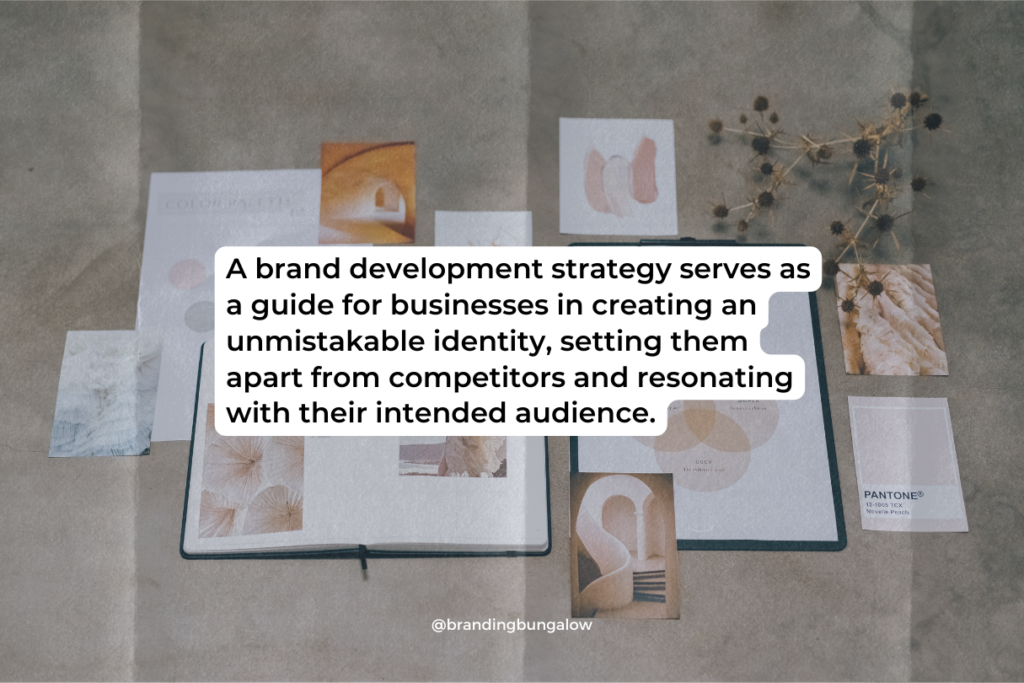
A solid brand strategy can boost a company’s lifetime value by up to 306%. But how do you craft such an effective approach that sets your business apart and accelerates growth? Take Nike’s “Dream Crazy” campaign starring Colin Kaepernick, which resulted in 31% sales increase – the message perfectly aligned with their values and caused quite an emotional impact. Crafting these kinds of campaigns requires some know-how. So what goes into making one successful branding plan?
Defining Branding Strategy
A brand development strategy serves as a guide for businesses in creating an unmistakable identity, setting them apart from competitors and resonating with their intended audience. It consists of several elements like voice, storytelling style, company values & message to be conveyed – all working together towards achieving the same goal: successful branding.
Building up a comprehensive approach to your brand is very important when you want the most out of it – customer loyalty will grow and so will knowledge about your business or product! This also requires preparation just like any other type of project that needs planning, including defining objectives specific for building up a powerful marketing plan based on brands’ mission and established key-values previously mentioned here above.
The Role of Branding Strategy in Business Growth
A brand strategy, which is crafted properly, not only helps a business define its market status, but also leads to more profits and building customer loyalty for the long run. To attain this objective, your branding plan should have some main points such as finding out the purpose of the brand, putting forward positioning statements that are unique, and displaying values through actions. Having an attractive visual identity related to its core story. Conducting studies on target audience personas and their behavior in relation to markets. Uber, Webflow and Airbnb are all instances where these companies succeeded in implementing their brand strategies, bringing them ahead from competitors while increasing revenue growth along with being loyal among customers. An effective branding strategy can bring fruitful outcomes when understood by entrepreneurs as they help maximize market share leading to increased sales ultimately resulting in the generation of reliable patrons.
Key Components of an Effective Branding Strategy
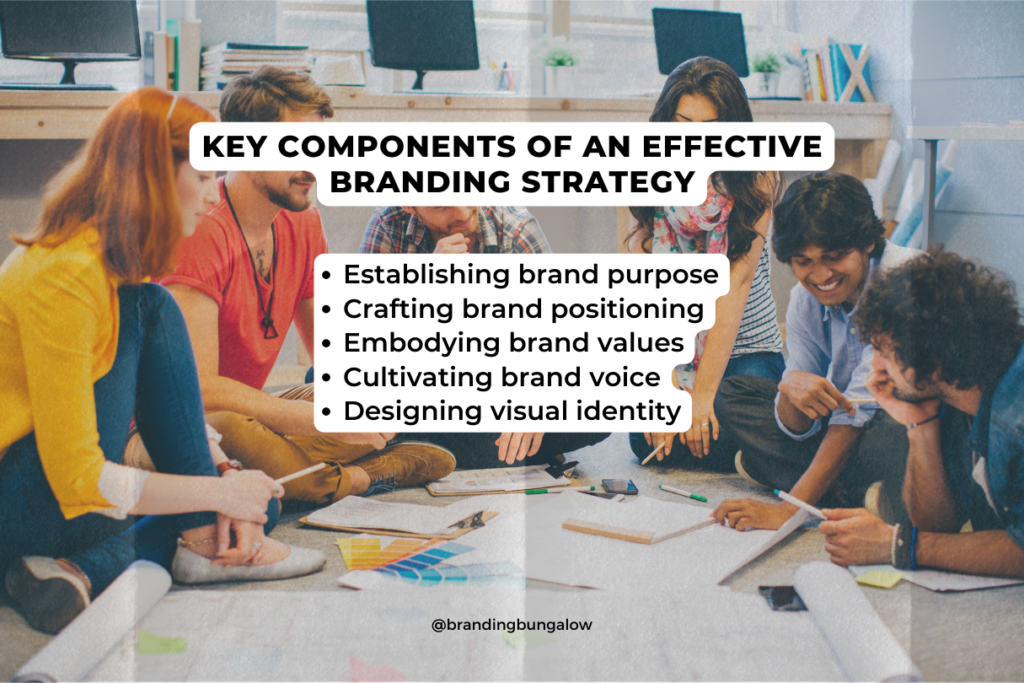
Having emphasized the importance of having a branding strategy, it is time to look into each element that makes up an effective one. These core parts make up your brand’s identity and messaging, which needs to attract its target market in order for your marketing endeavors to be successful.
This comprises defining the goal behind your brand, creating a unique presence within the marketplace, embodying values associated with it, and developing a consistent approach or voice when interacting with customers. We will now take an even closer look at these elements.
Establishing Brand Purpose
It is essential to make sure that the purpose of your brand resonates with the needs and wishes of your target audience in order to establish a strong connection. Crafting a meaningful mission statement helps you communicate what drives your business, revealing its identity and inspiring consistency across all branding elements. It’s also useful for staying true to core values as it serves as an ongoing reference point when creating customer experiences. Having this guiding light ensures that all aspects of building up the brand are adequately addressed, no matter how frequently these changes over time.
Crafting Brand Positioning
Crafting a strong brand identity with an effective positioning statement is crucial to stand out from the competition. Take Nike for example, which took almost two decades crafting their current brand strategy. Creating such a powerful and unique position in the market allows your business to avoid being part of that 77% statistic of brands no one would miss if they were gone.
By making use of tools like benefits ladder, you can make sure each element reinforces the emotional advantages customers get by choosing your product or service over others’. Doing so helps build both trustworthiness and recognition amongst its target audience – securing yourself as a provider who’s worth investing in!
Embodying Brand Values
Your brand values should act as the foundation of your branding strategy – it’s essential that you stay true to them in order for your target audience to trust and support what you are representing. Understand their needs, wants and align with these beliefs by tailoring messages so they resonate deeply. This will create a positive connection between customers and your brand. Doing this guarantees success both short term through customer loyalty but also long term through upholding those core values too.
Cultivating Brand Voice and Tone
Maintaining a consistent brand voice and tone across all touchpoints is essential to create an impression that will stand out in your target audience’s minds. The questions you should ask yourself for developing this kind of strong, recognizable identity include: What words or phrases can people link with your brand? How would you characterize its personality? And if it were speaking aloud, what type of language and attitude would be used by your brand then?
Answering those inquiries and being vigilant about preserving consistency between messages on different marketing channels allows building a unique character which potential customers won’t easily forget. This way more often than not gives rise to a branded image which marks one’s success as much as their business itself does!
Designing Visual Identity
It is important to create a distinctive and memorable brand experience for your customers, which begins with having an effective visual identity. This can involve such features as: logo design, color palette choice, typography selection, and graphic elements that all embody the values of your company in order to attractively appeal to the target audience.
For this reason, it’s beneficial to collaborate closely with creative teams like product designers or graphical developers when forming these visuals. Striving for consistency across various touchpoints will help foster recognition within people while fortifying their trust in you as a business. The objective should always be creating an impactful image through careful construction of visual components according to what best resonates with your brand’s mission statement so make sure each part has been properly thought out before launch!
Building and Implementing Your Branding Strategy
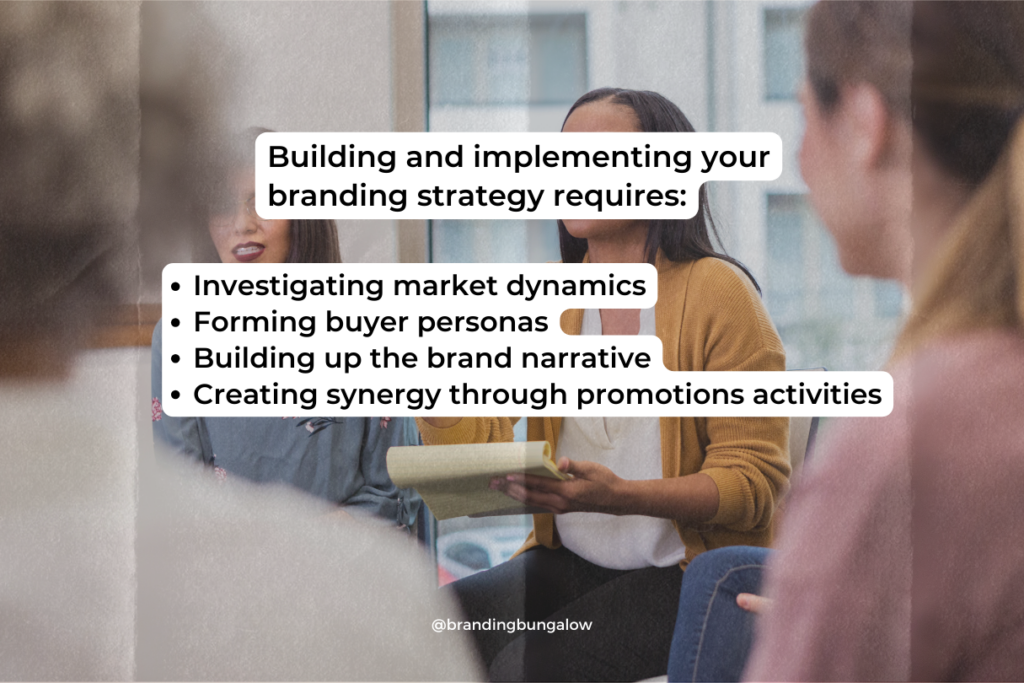
To craft an effective brand marketing strategy, a thorough comprehension of all its components is essential. To create and implement such a plan requires meticulous steps that encompass research into your target audience, market analysis, as well as uniformity in messaging across touchpoints. This article shall provide guidance to bring this project from conception to fruition by exploring the outlined stages:
- Investigating market dynamics
- Forming buyer personas
- Building up the brand narrative
- Creating synergy through promotions activities
We will take these crucial actions one at time in more depth, starting with data collection pertinent for accurately gauging what potential clients are seeking. We will follow this by devising distinguishable profiles or ‘personas’ associated with your company’s story which serves central when establishing memorable content, and then fusing them together to form a singular cohesive message before executing any mission.
Conducting Market Research
Market research is essential for a successful brand marketing strategy. It provides you with in-depth understanding of your target audience such as their requirements, desires and motivations so that you can tailor fit the product messaging and branding accordingly. It assists brands to make shrewd decisions about their overall marketing plan while saving both time & money.
To collect useful information regarding your desired market presence, taking into consideration data including consumer insights, competitive analysis based on current trends or perception within each specific area helps build the groundwork towards building an effective brand development scheme through customer feedback segregation according to Brand Equity & internal analyses used along its entirety among other sources of intelligence gather by means of efficient Market Research methods.
By properly implementing all these facts learnt from conducting extensive studies related to establishing traction in this industry, one would be able to generate insightful conclusions related to making adjustments needed when studying the intended targeted demographic.
Developing Target Customer Personas
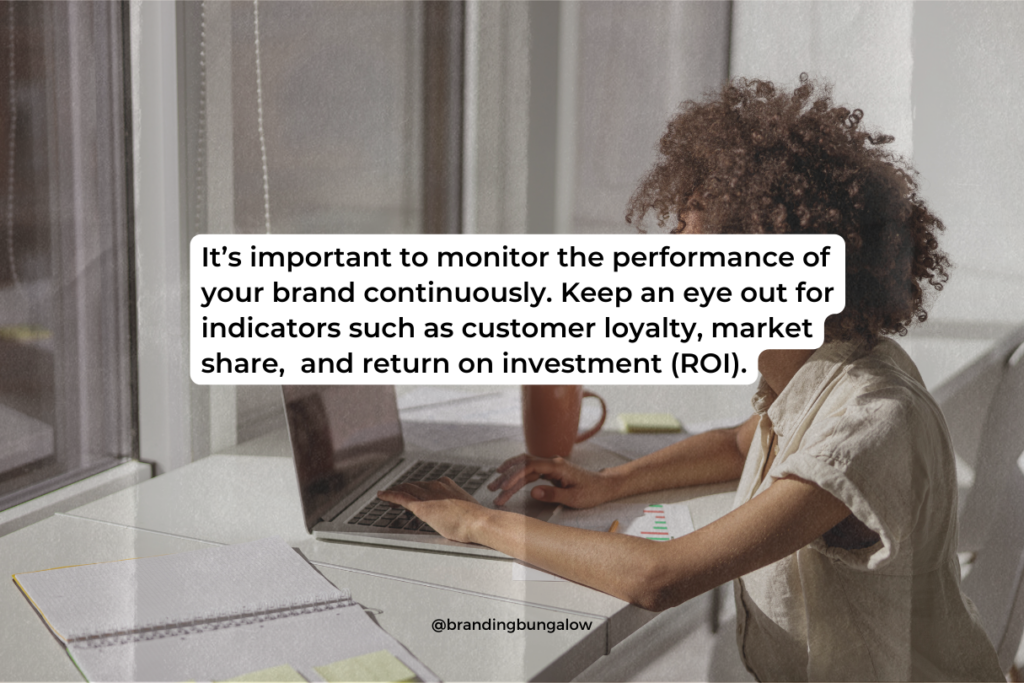
For successful businesses, it is important to create customer personas that are tailored to the specific needs of your target audience. Market research and analysis of existing customers can provide valuable insights into what they want from products or services. Using this information you can craft well-defined profiles which accurately reflect them. This allows for a branding strategy optimized towards their preferences, leading to better customer loyalty as well as reinforcing a cohesive visual identity across all aspects associated with the brand.
Creating a Memorable Brand Story
Developing a captivating brand story is key in setting your business apart from competitors and developing an emotional connection with customers. To do this, you need to create a narrative that reflects: the beginnings of your brand, its values, and what sets it apart from others on the market. How people will emotionally connect with it and the vision for its future development.
When creating such stories, using creative metaphors as well as imagery can be effective in making them stand out more and resonate deeply among target audiences. Establishing an emotional link between consumers; Your company can lead to increased loyalty, which contributes heavily to success over time!
Aligning Marketing Efforts
To guarantee that your marketing initiatives correspond to your brand, it is key to have a solid and effective branding approach. Here are the steps you should take:
- Identify what makes up the core of your brand – its values, identity etc.
- Ensure any content created reflects these values and applies appropriately to who it’s meant for (the audience)
Logo use, typography choice color palette employed as well as other images used all play into creating guidelines which encompass tone plus message so they convey effectively with clarity how awesomely powerful an idea or emotion can be when supported by one single consistent expression – every element helping bring something special from within our hearts outwards towards others. This means establishing messaging architecture that gets across positively why people should choose exactly YOUR specific brand! With this done successfully, then promoting through original material combining words & visuals across many channels will make sure customers recognize you effortlessly while maintaining uniqueness too!
Monitoring and Adjusting Your Strategy
It’s important to monitor the performance of your brand continuously so you can adjust it accordingly. Keep an eye out for indicators such as customer loyalty, market share, return on investment (ROI), and brand awareness that let you know how well the strategy is doing. Compare these stats with those of competitors in order to identify potential opportunities or gaps in the marketplace. Tracking this data will ensure your branding remains impactful and true to its objectives relative to both current trends and customers’ preferences alike.
By listening carefully to audience responses when implementing a branding strategy – then regularly assessing their reactions – brands are able to hold onto relevance, remain engaging, while still achieving key goals set by management teams across all areas like equity building etc. It’s necessary for businesses to adapt through continual evaluation. This way, they can be sure their marketing tactics are attuned appropriately via adaption changes.
Case Studies: Successful Branding Strategies in Action
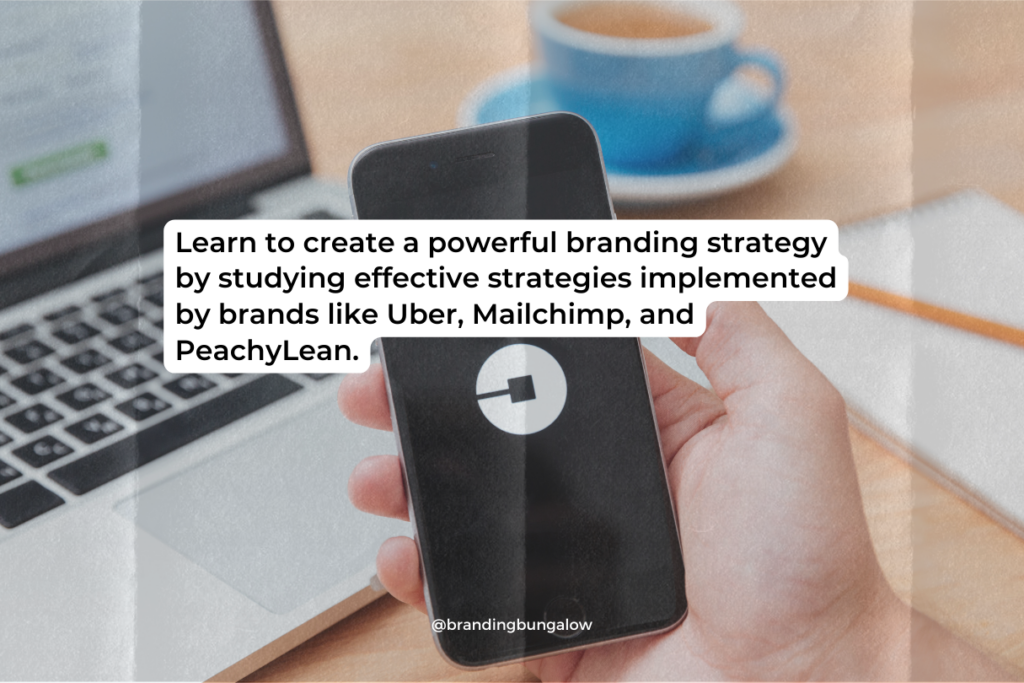
By studying effective brand strategies implemented by brands like PeachyLean, Mailchimp, Uber, Good Pair Days and Riverford Organic Farmers that have been successful in driving revenue growth as well as customer loyalty through their strong identity creation, one can learn to create a powerful branding strategy for themselves. Tailor branding efforts to the target audience so it resonates with them, which will then drive long-term success. This showcases just how important creating an excellent brand strategy is when building recognition of your business, increasing awareness while achieving greater heights overall.
Overcoming Common Branding Challenges
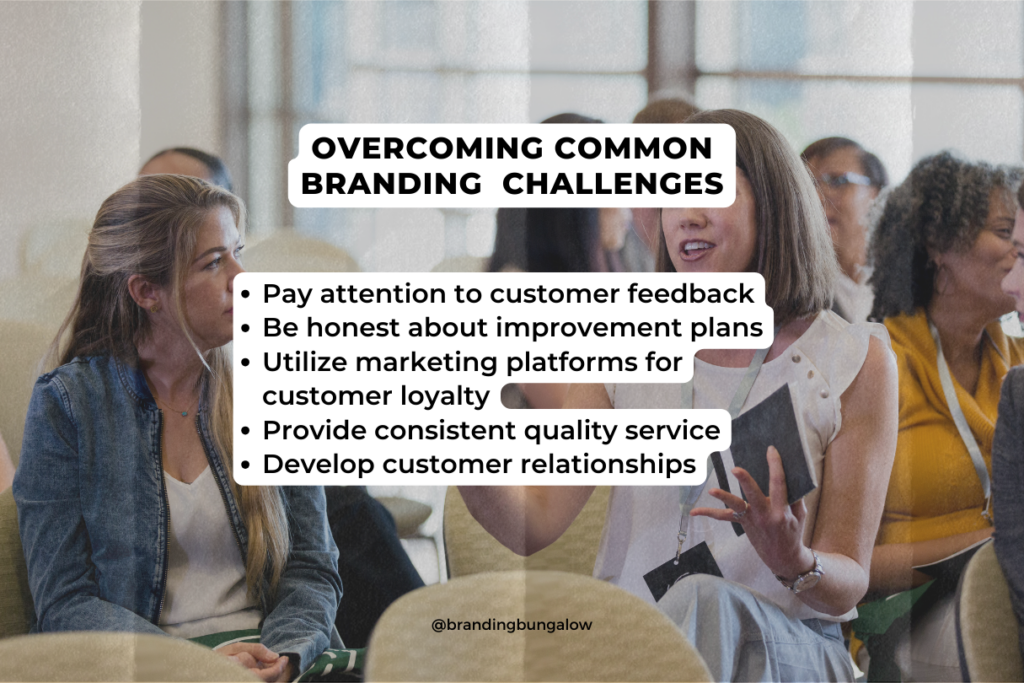
Any successful branding strategy must recognize and prepare for possible difficulties that could arise. One common challenge is the damage inflicted by negative brand perceptions. To combat this, here are some effective measures:
- Pay attention to customer feedback in order to discover any underlying issues they may have with your brand
- Be honest about what steps you’re taking towards improvement so people will understand your commitment
- Use marketing/communications efforts as a platform from which positive associations can be established – such as trustworthiness or dependability
- Provide first-class service on an ongoing basis and live up to all of the promises made concerning brands loyalty initiatives, etc.;
- Develop relationships built upon mutual understanding with customers where their needs and expectations are consistently met. This way, one can guarantee the success of its company’s reputation remains intact no matter how big the obstacle faced might seem at times.
Tips and Tools for Enhancing Your Branding Strategy

Establishing a successful brand necessitates continuous work and modification. To achieve long-term success, it’s important to embrace the following ideas and tools: First, discover your target audience while constructing an original brand story. Secondly, build up trademark principles using asset management software for consistency in all marketing material. Keep watch of opponents as well as stay informed on current trends can reveal potential openings for expansion. Lastly, track KPIs accordingly then adjust your plan based off performance analysis or consumer insight from feedback. By utilizing these tips with compatible resources you will create a powerful yet effective branding approach which intensifies growth but also establish steady connection between customers and yourself.
Summary
An effective brand strategy is the cornerstone of any business that wishes to stand apart from its competition, bolster customer loyalty and increase revenue. Crafting a powerful identity through learning core elements of successful branding practices, following a systematic approach and studying case studies in order to overcome common obstacles and form an emotional connection with customers Your branding goes far beyond simply having flashy logos or memorable slogans. It must embody the very soul of what you are offering as well as connecting directly with your desired target audience in order to ensure success long term.
Frequently Asked Questions
What are the four 4 types of branding strategies?
You can employ various brand strategies, such as line extension, brand extension and flanker-fight branding strategy to craft a successful identity for your brand. These approaches, when implemented thoughtfully, could result in great success of the particular product or service represented by the specific company’s brands.
What are the 4 steps of branding?
Creating a successful brand involves understanding your company and audience, picking an appropriate message and positioning to portray how you want the public to perceive your business, ensuring consistency in communication across all channels while tracking progress along the way.
What is a successful branding strategy?
Branding strategies that are successful involve pinpointing the appropriate target market by recognizing their desires and offering useful value. By doing so, you’re utilizing your resources wisely to construct an impressive image for your brand name.
What are the 4 elements of branding?
A successful brand is comprised of four critical aspects: its identity, image, culture and personality. Having a consistent approach to all these elements helps shape the recognition of a strong brand.
What is the importance of a branding strategy?
Branding is incredibly valuable to any business as it allows them to develop a distinctive identity, foster customer loyalty and ultimately lead to an increase in revenue growth.
Recent Blog Entries
Discounts to Dubsado CRM, Helcim Payment Processing and...
Brand audits can save your business' sinking marketing ship.
What's happening to Coke and what you can learn from it.
Shop Products
Create a personalize brand board by taking elements from our 3 signature brand board templates.